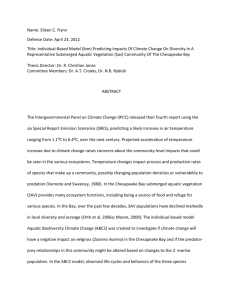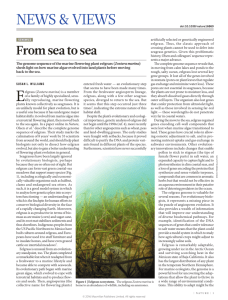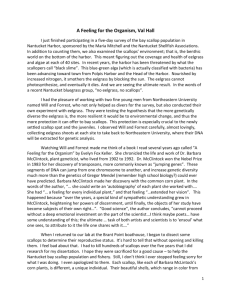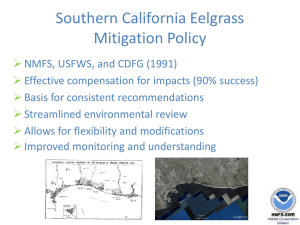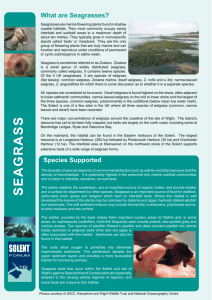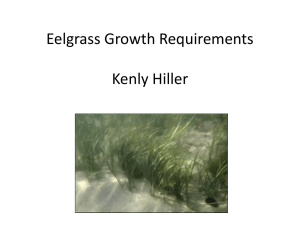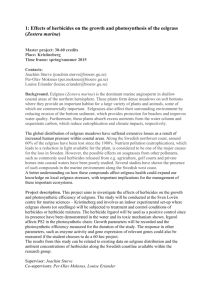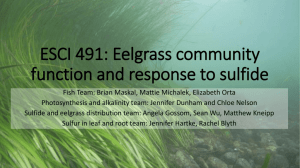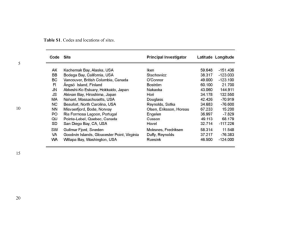A M I E
advertisement
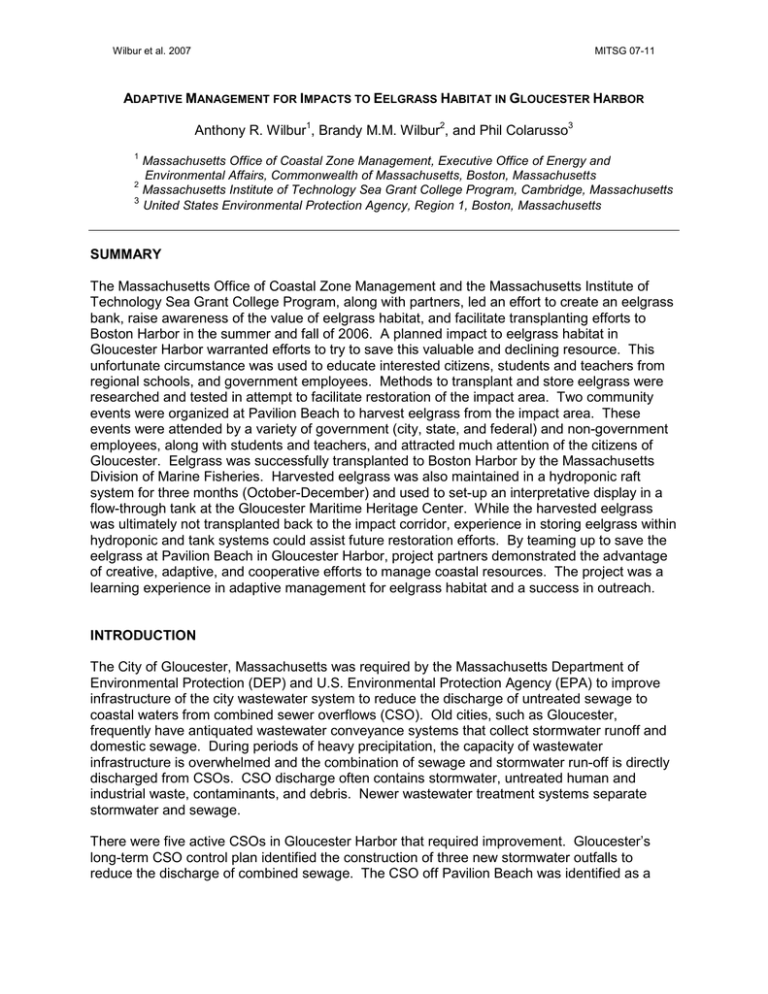
Wilbur et al. 2007 MITSG 07-11 ADAPTIVE MANAGEMENT FOR IMPACTS TO EELGRASS HABITAT IN GLOUCESTER HARBOR Anthony R. Wilbur1, Brandy M.M. Wilbur2, and Phil Colarusso3 1 Massachusetts Office of Coastal Zone Management, Executive Office of Energy and Environmental Affairs, Commonwealth of Massachusetts, Boston, Massachusetts 2 Massachusetts Institute of Technology Sea Grant College Program, Cambridge, Massachusetts 3 United States Environmental Protection Agency, Region 1, Boston, Massachusetts SUMMARY The Massachusetts Office of Coastal Zone Management and the Massachusetts Institute of Technology Sea Grant College Program, along with partners, led an effort to create an eelgrass bank, raise awareness of the value of eelgrass habitat, and facilitate transplanting efforts to Boston Harbor in the summer and fall of 2006. A planned impact to eelgrass habitat in Gloucester Harbor warranted efforts to try to save this valuable and declining resource. This unfortunate circumstance was used to educate interested citizens, students and teachers from regional schools, and government employees. Methods to transplant and store eelgrass were researched and tested in attempt to facilitate restoration of the impact area. Two community events were organized at Pavilion Beach to harvest eelgrass from the impact area. These events were attended by a variety of government (city, state, and federal) and non-government employees, along with students and teachers, and attracted much attention of the citizens of Gloucester. Eelgrass was successfully transplanted to Boston Harbor by the Massachusetts Division of Marine Fisheries. Harvested eelgrass was also maintained in a hydroponic raft system for three months (October-December) and used to set-up an interpretative display in a flow-through tank at the Gloucester Maritime Heritage Center. While the harvested eelgrass was ultimately not transplanted back to the impact corridor, experience in storing eelgrass within hydroponic and tank systems could assist future restoration efforts. By teaming up to save the eelgrass at Pavilion Beach in Gloucester Harbor, project partners demonstrated the advantage of creative, adaptive, and cooperative efforts to manage coastal resources. The project was a learning experience in adaptive management for eelgrass habitat and a success in outreach. INTRODUCTION The City of Gloucester, Massachusetts was required by the Massachusetts Department of Environmental Protection (DEP) and U.S. Environmental Protection Agency (EPA) to improve infrastructure of the city wastewater system to reduce the discharge of untreated sewage to coastal waters from combined sewer overflows (CSO). Old cities, such as Gloucester, frequently have antiquated wastewater conveyance systems that collect stormwater runoff and domestic sewage. During periods of heavy precipitation, the capacity of wastewater infrastructure is overwhelmed and the combination of sewage and stormwater run-off is directly discharged from CSOs. CSO discharge often contains stormwater, untreated human and industrial waste, contaminants, and debris. Newer wastewater treatment systems separate stormwater and sewage. There were five active CSOs in Gloucester Harbor that required improvement. Gloucester’s long-term CSO control plan identified the construction of three new stormwater outfalls to reduce the discharge of combined sewage. The CSO off Pavilion Beach was identified as a Wilbur et al. 2007 MITSG 07-11 priority for improvement because of potential human health impacts. Pavilion Beach is a heavily used urban beach located in downtown Gloucester. The location of the new outfall off Pavilion Beach was determined after a relatively simple alternatives analysis. Harbor Cove (inner Gloucester Harbor) and the southern Annisquam River were alternative locations but were ruled out primarily because of potential impacts to stored lobsters and shellfish, respectively. Additional issues, such as engineering feasibility, were also considered during the alternative analysis. Federal and state regulatory agencies met with the City of Gloucester and ultimately decided the new pipe would be constructed through Pavilion Beach into the subtidal environment. Construction of the new outfall included dredging a corridor for the extent of the pipe, laying the pipe in the trench, and backfilling the trench with rip rap and dredged material. Construction in the subtidal environment involved mooring a barge and dredging along the corridor off Pavilion Beach for several months (Figure 1). Eelgrass (Zostera marina), an underwater marine plant that creates a valuable shallow water habitat, was mapped off Pavilion Beach in 1995 and 2001 by the Massachusetts DEP FIGURE 1. Barge and dredge located over eelgrass bed at (Figure 2). Eelgrass habitat supports Pavilion Beach during outfall construction. an abundant diversity of life, stabilizes seafloor sediments and adjacent shorelines, helps maintain water quality, and is a critical component of the marine food web. While the populations of eelgrass are severely diminished from historic levels and continue to steadily decline throughout most of its range in the north Atlantic Ocean, eelgrass in Gloucester Harbor appeared relatively stable during the recent past and expanded in certain areas within the harbor. The eelgrass bed off Pavilion Beach was an area that was expanding prior to construction (e.g., Metcalf and Eddy 2005). The presence or proximity of this valuable habitat was apparently not taken into account or was determined less important than other resources during the alternatives analysis of the new outfall. When it was discovered that eelgrass was present in the project area, regulators acknowledged the importance of eelgrass habitat and set permit requirements in an attempt to reduce impacts to the eelgrass bed at Pavilion Beach. Permit requirements for construction of the new outfall included extending the length of pipe beyond the deepwater edge of the eelgrass, not allowing side casting of the dredged material, and requiring the use of an environmental bucket to minimize turbidity and sedimentation. Regulators also set an environmental window (i.e., seasonal restriction on in-water construction) to protect the ecology of the eelgrass meadow. The City was also required to develop a mitigation plan for eelgrass restoration in the impact area (i.e., Metcalf and Eddy 2006). Even with permit requirements to reduce impacts, there was a planned impact of approximately a half acre of eelgrass habitat. The planned impact area (i.e., ~0.5 acre) expanded to greater than an acre during construction, and construction was also not completed within the environmental window. The impact to eelgrass habitat warranted a creative response to 2 Wilbur et al. 2007 MITSG 07-11 attempt to make the best of an unfortunate situation. In response, the Massachusetts Office of Coastal Zone Management (CZM) partnered with the Massachusetts Institute of Technology (MIT) Sea Grant College Program, City of Gloucester, Gloucester Maritime Heritage Center (GMHC), U.S. EPA, and Massachusetts Division of Marine Fisheries (DMF) to save eelgrass in the project area and raise awareness of eelgrass habitat. Partners combined resources and expertise to: (1) Facilitate ongoing eelgrass restoration in Boston Harbor, (2) Study and develop methodology to store eelgrass and monitor survival of eelgrass in a hydroponic raft and flow-through seawater tank, and (3) Raise awareness of the ecological value of eelgrass and CSO abatement. The focus of this report is the hydroponic raft, outdoor flow-through tank, and outreach efforts. While the Boston Harbor transplant is summarized in this report and represented an important activity, DMF continues to implement the restoration program and provides results of restoration activities in separate reports. Please see DMF reports for further information on Boston Harbor restoration (www.mass.gov/dfwele/dmf/programsandprojects/hubline/eelgrass.htm). FIGURE 2. Distribution of eelgrass, as mapped by MA DEP (1995 and 2001), and location of Pavilion Beach in Gloucester Harbor. PARTNERS AND ROLES Objectives of this initiative evolved as partners confirmed their participation and available resources. While there was little to no funding dedicated to this effort, partners agreed that action was required for the planned impact to eelgrass. Common themes of research, restoration, and stewardship were considered and discussed to establish project goals. Uncertainty played a role in developing and implementing the plan to save the eelgrass, so 3 Wilbur et al. 2007 MITSG 07-11 principles of adaptive management (see Stankey et al. 2005) were required to maintain focus to ultimately identify and achieve objectives. As available resources were realized throughout the project, specific objectives had to be modified to achieve constructive outcomes. For example, diving resources, including staff (divers), money, and time, were not available to harvest all eelgrass within the impact corridor, and space to transplant eelgrass from the corridor was also limited. Outreach was a consistent theme that needed little funding but depended on in-kind contributions. While sufficient staff time and resources were not available to accomplish complex research and restoration, documenting the process to store eelgrass and monitoring the condition of eelgrass was accomplished to facilitate future efforts. Each partner contributed, ranging from staff time and consultation to equipment and supplies. The collective group was productive and enabled a positive experience for the City of Gloucester, community, and government agencies (Table 1). In addition, volunteers from local schools and interested citizens, along with a marine biologist from Mass Audubon, assisted with the initiative. TABLE 1. Partners in adaptive management for eelgrass habitat project. AGENCY – INSTITUTION ROLE WEB SITE Massachusetts Office of Coastal Zone Management Project management Outreach support Technical assistance www.mass.gov/czm Massachusetts Institute of Technology Sea Grant Stewardship and education Raft and tank design, construction and maintenance seagrant.mit.edu Gloucester Maritime Heritage Center Stewardship, equipment, space and tank/raft maintenance www.gloucestermaritimecenter.org/ Equipment and staff support www.ci.gloucester.ma.us/ US Environmental Protection Agency Experts in coastal ecology Technical guidance Dive support www.epa.gov/Region1/ Massachusetts Division of Marine Fisheries Experts in marine fisheries Dive support Monitoring assistance www.mass.gov/dfwele/dmf/ City of Gloucester 1 1 Staff from the Engineering, Harbormaster, Shellfish, and Community Development (Planning & Conservation) Departments participated in several aspects of the project. Environmental consultants, Metcalf and Eddy, were hired by the City of Gloucester for the Washington Street drainage project and helped harvest eelgrass. EELGRASS RESTORATION IN BOSTON HARBOR DMF has an ongoing eelgrass restoration project in Boston Harbor. Eelgrass shoots are typically collected from donor beds and transplanted to Boston Harbor. Since eelgrass was to be dredged at Pavilion Beach during the CSO construction, transplanting plants from Pavilion Beach eliminated the need for harvesting at the donor bed, which is a productive bed located off Nahant, for this restoration effort. The transplant to Boston Harbor also saved eelgrass from Gloucester that would have ultimately been destroyed and lost from the coastal and ocean ecosystem. 4 Wilbur et al. 2007 MITSG 07-11 Harvesting plants from Pavilion Beach required adapting conditions of the environmental windows set by regulators for the CSO construction project. Environmental windows for constructing the outfall were designed by regulatory agencies to protect the ecology of the Pavilion Beach eelgrass bed. Collecting eelgrass in the impact corridor to transplant to Boston Harbor presented a level of disturbance during the environmental window. Resource agencies agreed to allow harvesting within the impact corridor, while maintaining the spirit of the permit (e.g., protect eelgrass prior to construction) by using a dispersed harvesting method. Dispersed harvesting is believed to leave no noticeable impact to the eelgrass bed. Harvest areas were carefully planned in the impact area not to overlap and no more than 20% of eelgrass from a 1m2 quadrat were collected (A. Leschen personal communication). Once harvesting requirements to protect the Pavilion Beach eelgrass were set, a community event was organized to collect plants. On 1 August 2006, approximately 8,000 eelgrass shoots were harvested from Pavilion Beach. Transects were set along the center of the impact corridor and 100’ to the east and west of the centerline. These transects focused collection efforts into the impact corridor. A team of divers from DMF, US EPA, and Metcalf & Eddy (as the City of Gloucester consultants) collected eelgrass and transferred bags of eelgrass to staff in a dory (loaned by GMHC) and a kayak from the National Oceanic and Atmospheric Administration’s National Marine Fisheries Service. Eelgrass was rowed to shore, where it was then sorted and counted by volunteers in preparation for transport to Boston Harbor. DMF divers planted the eelgrass in Boston Harbor the following day. These transplants are monitored as part of an on-going monitoring program to determine success of restoration efforts (T. Evans personal communication). This event was particularly successful in outreach (Figure 3). Approximately 45 people from government agencies, including city, state, and federal employees, and volunteers worked together to harvest eelgrass and process the eelgrass in preparation for transplant in Boston Harbor. A city harbormaster boat was also used to monitor dive activity and maintain a safety area around the diving operations. As it was the middle of summer, many citizens and tourists stopped and learned about the project and the importance of eelgrass, with some offering assistance in processing the plants. FIGURE 3. Activity on beach and launching a dory during the eelgrass harvesting event. Floats offshore (bottom photograph) mark the impact corridor. 5 Wilbur et al. 2007 MITSG 07-11 EELGRASS BANK While facilitating eelgrass restoration in Boston Harbor was a success, a large abundance of eelgrass remained in the impact corridor. Considerable brainstorming went into other options to save the eelgrass from the impact area. Transplanting eelgrass to another location was not feasible because there was limited data to support selecting an appropriate site. Therefore, MIT Sea Grant and CZM researched and developed methodology for storing harvested eelgrass for future eelgrass restoration within the outfall corridor in Gloucester Harbor or the Annisquam River. Education opportunities were also outlined as part of the harvesting and storing efforts. The objectives of the effort were to (1) salvage as much eelgrass from impact corridor as possible; (2) design, construct, and populate a system to store eelgrass; (3) monitor survival and condition of stored eelgrass; and (4) support regional education programs. Depending on the abundance and condition of the stored eelgrass in the spring (2007), eelgrass would be transplanted back to the impact corridor after construction and/or used for test transplants in the Annisquam River. The City of Gloucester was interested in this concept, as it would reduce costs required to harvest eelgrass from a donor bed to transplant to the impact corridor. Transplanting eelgrass to test plots in the Annisquam River would also assist an ongoing study by CZM on restoration suitability. Furthermore and more important, using the stored eelgrass for transplant would eliminate the potential impact to donor beds for both the Pavilion Beach restoration and Annisquam River test transplants, which would save a valuable resource that is extremely threatened. There was, however, little to no scientific literature related to establishing and maintaining an eelgrass bank. As methodology to store and grow eelgrass was researched, partners communicated to the city and regulatory agencies that success was not guaranteed and the condition of the plants after storage was unknown. Given this uncertainty, regulatory agencies required that the City use the banked eelgrass (if it survived) for no more than 50% of their transplant. This requirement was established to ensure the appropriate and successful restoration of the impacted eelgrass habitat that was developed in the accepted mitigation plan (Metcalf & Eddy 2006). Scientific literature was researched and eelgrass scientists with experience storing eelgrass were contacted to develop a plan. Marine scientists at Battelle (Sequim, WA) and Cornell University (Long Island, NY) particularly guided this project. Battelle scientists successfully stockpiled and grew eelgrass in flowing seawater tanks and maintained and expanded a population of eelgrass for three years. They started with 5,500 shoots and had 17,350 after 3 growing seasons, with the population peaking at 30,000 (Borde et al. 2001). Cornell University also has an eelgrass restoration program that includes propagating eelgrass. Drs. Ron Thom (Battelle, WA) and Chris Pickerell (Cornell University, Long Island Sound) provided valuable insight on approaches to sustain contained eelgrass populations. The literature search also helped form concepts to examine in developing the eelgrass bank. A major consideration was the limited space available, both in-water and shore-side. Furthermore, resources to collect eelgrass (e.g., divers and shore-side staff) were also limited and it was determined early in the discussion that all the eelgrass in the impact area could not be harvested and stored. The uncertainty in results also influenced the amount of effort to put toward saving the eelgrass. That is – dedicating substantial resources to an unknown outcome was not an effective use of staff time and equipment. 6 Wilbur et al. 2007 MITSG 07-11 Eelgrass restoration is a relatively new management strategy in New England. While studies explain eelgrass biology and ecology, appropriate restoration siting methodology, and planting techniques, creating an eelgrass bank has not been attempted in New England. The approach to create an eelgrass bank, included designing and constructing a hydroponic eelgrass raft and flow-through seawater tank, and populating these systems with harvested eelgrass. Eelgrass Raft MIT Sea Grant designed and constructed an experimental hydroponic raft, meaning eelgrass was secured to the raft without substrate, to store eelgrass. The raft was constructed with a metal and wood frame with support rope positioned at 15” intervals lengthwise and crossways, stretched burlap-like mesh to contain plants, and floatation (four 15" polyfloats) to maintain vertical location in the water column (C. Goudey personal communication; Figure 4). The burlap-like material was manufactured coconut fiber that FIGURE 4. Schematic of 30’ x 10’ eelgrass raft (C. Goudey personal was biodegradable and highly communication). permeable. This material was stretched over the top of the raft frame and used to make 27, 1m2 purses to contain the eelgrass. Individual plants were pulled through the top layer of the purse, and rhizomes were weaved through the bottom layer, creating a ‘sandwich’ or ‘purse’ to secure plants (Figure 5). The completed 1m2 purse was attached to the top of the raft frame, and leaves floated above the purse. Approximately 150 shoots were weaved into each purse, resulting in nearly 4,000 shoots secured to the float. FIGURE 5. Schematic of ‘weaved’ eelgrass between two layers of coconut fiber (T. Evans personal communication) and photograph of purse being deployed to raft. 7 Wilbur et al. 2007 MITSG 07-11 Water circulated through the material and light accessed the weaved roots and nodes. It was hoped that as roots grew, they would anchor and assimilate into the burlap, and the 1m2 purses could be transported to transplant sites and secured to the bottom. Through time, the burlap would degrade on the seafloor, leaving the eelgrass (roots growing into the seafloor and leaves floating). The raft was designed to limit handling of the plants, from initial population of the raft to subsequent transplant. Limited handling would increase the potential for successful restoration. Eelgrass Tank MIT Sea Grant set-up a 1,900 gallon fiberglass tank (10’x10’x3’) at the GMHC (Figure 6). The tank was located in direct sunlight on the pier at GMHC and filled with 3” of sand-cobble mix (~1 cubic yard). A commercial dredge from Gloucester (Great Eastern) dredged and transported the sand-cobble mix – predominantly sand – from Pavilion Beach to the pier at GMHC. Material was shoveled from the pier and deposited and graded in the tank. The tank had flow-through seawater directly from Gloucester Harbor. Water was pumped from the harbor and drained through a 3” center standpipe, creating a circular current in the tank. The direction of water flow was periodically changed. Water depth was 24”. Creatures, such as chink snail (Lacuna vinca), periwinkle (Littorina littoria) and fish (e.g., cunner, Tautogolabrus adspersus), naturally inhabiting eelgrass habitat, were added to the tank to demonstrate the diversity of life in eelgrass habitat and provide control algal growth. FIGURE 6. Flow-through tank at GMHC, showing (clockwise from top left) water flow with center standpipe, planted eelgrass, and tank with mural of eelgrass habitat and adjacent informational poster. 8 Wilbur et al. 2007 MITSG 07-11 Populating Raft & Tank MIT Sea Grant sponsored a second community event on 25 September 2006 to harvest eelgrass from the impact corridor at Pavilion Beach. The goal of the event was to collect as many eelgrass shoots as possible and populate the eelgrass raft and tank, along with educating volunteers about the ecological value of eelgrass and importance of wastewater management. The event was effective outreach to local schools and interested citizens with over 100 people participating. Students and teachers from four schools (Dana Hall, Winthrop Middle School, Essex Agriculture and Technical High School, and Minuteman High School) that work with MIT Sea Grant on environmental education and stewardship projects, as well as city and government employees, participated in the event. The activity on the beach also attracted attention of citizens and the local newspaper (Figure 3 and 7). The raft was floated to Pavilion Beach (from GMHC) and anchored in shallow water. The pipeline corridor was marked FIGURE 7. Students preparing shoots for transplant and by buoys and sinking line, similar to weaving shoots into purses. procedures followed during the first harvesting effort. Divers entered the water and harvested as much eelgrass as possible within the impact corridor. Harvesting focused on the most abundant and healthy areas of eelgrass, given that the eelgrass within the corridor was to be dredged immediately after the harvest (i.e., there was no need to minimize impacts to the eelgrass bed by using dispersed harvesting). Divers filled bags with eelgrass and transferred full bags to boats. The boats (dories from GMHC) transported the eelgrass to shore, where the eelgrass was sorted and counted by partners and volunteers. Over 4,000 shoots of eelgrass were weaved into the purses over three days (26-29 September) and attached to the raft. The eelgrass raft was secured between two piers at GMHC with good tidal flushing (Figure 8). The piers shaded the raft for periods of time at certain tides and time of day. Shoots were also planted in the tank at approximately 240 shoots/m2, totaling approximately 2,200 shoots. The remainder of harvested eelgrass was distributed to 10 regional schools participating in MIT Sea Grant’s eelgrass stewardship project. 9 Wilbur et al. 2007 MITSG 07-11 FIGURE 8. Raft with transplanted eelgrass floating between two piers at GMHC. Results – Monitoring Data & Observations The feasibility of creating an eelgrass bank was examined by monitoring the condition of eelgrass stored in the raft and tank. Hydroponics is not a well researched topic for marine plants (e.g., Biber 2006), and attempting to store eelgrass in a raft could help determine the use of this technique for storing and/or growing eelgrass. Six to 10 haphazard quadrats (0.25m2) were sampled in the raft and tank biweekly from October to December 2006. Shoot density (#/0.25m2) and relative abundance of epiphytes and wasting disease were measured in each quadrat. Canopy height (cm), estimated by 80% (not the tallest leaf) of leaves within a quadrat, and leaf length (cm) and width (mm) were measured in the tank. Shoot density was extrapolated to #/1.0m2, and measures of epiphytes and wasting disease are presented as observations in this report. Shoot density and canopy height are presented as mean ± standard deviation. The approximate starting shoot density on the raft was 150/m2. Individual measurements of shoot density were variable, as evidence of the standard deviation calculation. Mean shoot density on the raft was, however, relatively consistent from October to November and declined in December (Figure 9). Filamentous algae accumulated on the raft and eelgrass in mid to late October. While the raft and eelgrass appeared covered with algae, most of the algae was not attached to the FIGURE 9. Mean shoot density (#/m2) in raft from October to December 2006. 10 Wilbur et al. 2007 MITSG 07-11 eelgrass and was easily brushed away. Water was moved over the raft and eelgrass by sweeping your arm over the raft from the middle to the edge, creating a current through and over the raft. The algae ‘blew’ off the raft and sank to the bottom. Efforts to brush the filamentous algae from the raft seemed relatively successful, as the eelgrass typically floated above the burlap-like material that was fouled and appeared healthy green (Figure 10). The abundance of algae seemed to decline in late November through December. A major and unexpected influence on eelgrass survival was grazing by swans and Canadian geese. Swans and geese were frequently observed pulling and eating shoots FIGURE 10. Underwater view of eelgrass on raft. off the raft in the late fall and early winter. We surmise that once naturally occurring eelgrass declined, the swans and geese located the floating raft and took advantage of an easy meal. The combination of grazing and fouling ultimately reduced the abundance of eelgrass to nearly zero. The raft was dismantled in May 2007. The approximate starting shoot density in the outdoor tank was 240/m2. There was an initial decrease in shoot density, and then shoot density was relatively stable from October to November with a slight decline in December (Figure 11). Epiphytes covered much of the tank and eelgrass in October and early November. Creatures, such as chink snails, were added to the tank to attempt to control algal growth but did not result in a noticeable decrease in algae. There were no notable FIGURE 11. Mean shoot density (#/m2) in tank from October to December 2006. changes in leaf length or width. Canopy height (cm) appeared stable in October (13 Oct = 49±3cm; 27 Oct = 45±6cm) and November (10 Nov = 45±4cm; 22 Nov = 44±11cm) and declined in December (29 Dec = 27±6cm). Temperature dramatically declined in January – March 2007, and shoot density and canopy height subsequently declined (personal observation). Shoots were counted in spring 2007, with approximately 70 shoots in the tank surviving the winter. Ten of the remaining shoots produced 11 Wilbur et al. 2007 MITSG 07-11 flowers and seeds during the summer of 2007, showing that the plants that did survive in the tank were healthy. While we did not quantify the abundance of creatures in the tank, we noticed an increase in abundance of chink snails and amphipods – both grazers – and barnacles in the tank in summer 2007. The tank had no filtration and was flow-through which allowed creatures to enter the tank as larvae, and the larvae settled into the tank. The abundance of grazers seemed to better control algae during summer 2007. Scientists from Washington explained that it would take time to establish an ecosystem in the tank, and that once the ecosystem was established creatures would hopefully maintain algae abundance (Borde et al. 2001; Thom personal communication). The tank remains at the GMHC as an interpretative display of eelgrass habitat. OUTREACH – RAISING AWARENESS AND PROMOTING STEWARDSHIP From the beginning discussions, education and outreach were critically important aspects of this cooperative project. Decision makers and city planners were unaware of the location – and possibly the ecological value – of eelgrass in Gloucester Harbor. While this lack of awareness ultimately led to the destruction of an important coastal resource, partners agreed to use the unfortunate circumstance to raise awareness and promote stewardship of eelgrass habitat. Each community event was an excellent hands-on experience for participants, and efforts through this project were useful examples of adaptive management for MIT Sea Grant’s eelgrass stewardship project (http://seagrantdev.mit.edu/eelgrass/). The event was used to educate students and teachers participating in an ongoing eelgrass stewardship project, while students and teachers, along with government employees, participated in sorting eelgrass and identifying species within the eelgrass samples collected from the impact area. Harvested eelgrass was also used to populate small recirculating aquariums in 10 local schools. Students (and teachers) learned about eelgrass biology and its role as an important habitat for marine species. Many classrooms developed outreach material about eelgrass and distributed it throughout their schools and communities. Staff from CZM, US EPA, and MIT Sea Grant also visited classrooms to discuss management implications of the Pavilion Beach project, creating an eelgrass bank, and the need for increased protection of eelgrass habitat. MIT Sea Grant and CZM also developed two interpretative displays. A poster describing the CSO project, ecological values of eelgrass, and the eelgrass bank project and a large orange construction Eelgrass Habitat Restoration sign (Figure 12) were displayed at Pavilion Beach. The City of Gloucester manufactured two orange construction signs. A display at the GMHC was set-up adjacent to the eelgrass tank to describe eelgrass habitat (Figure 6). The display at the GMHC complements existing information on other habitats, such salt marsh and rocky intertidal zones. Both displays remain and represent a continuous effort to increase awareness of eelgrass habitat. In addition to an article published by the Gloucester Times (28 September 2006), two articles were published by MIT Sea Grant and CZM (Cohen 2007; Wilbur et al. 2007). These publications have regional and national distributions and further communicated the importance of eelgrass habitat and objectives of this project. 12 Wilbur et al. 2007 MITSG 07-11 FIGURE 12. Eelgrass Habitat Restoration sign at Pavilion Beach. DISCUSSION Adaptive management is an approach, including hands-on actions, to learn from what you do and provides the basis for changes in subsequent practices and policies (reviewed by Stankey et al. 2005). This project was an example of this strategy. The planned impacts to the eelgrass at Pavilion Beach required mitigation, as part of a formal regulatory process (Metcalf and Eddy 2006). However, the removal of eelgrass habitat warranted additional efforts to attempt to save this valuable and declining resource, and eelgrass restoration – as required by regulatory agencies – is not a guaranteed success. Furthermore, using eelgrass that would be dredged and lost to the coastal ecosystem highlights the value of this resource that is dramatically diminished from historic levels. By participating, government partners, some of whom were involved in the siting of the project, helped raise awareness of eelgrass habitat, transplanted eelgrass, and demonstrated impact to eelgrass is an unacceptable management strategy. Studying approaches and attempting to store eelgrass was also a learning experience. Overall, storing the eelgrass in the raft was successful from the end of September to December 2006. Challenges included algal fouling and grazing. The New England winter was also influential in the survival of eelgrass in the raft and tank. This project helped understand the ability to store eelgrass in systems without substrate. As this project was a demonstration, further research is required to determine the best methods for hydroponics. Experience from this project could help inform the development of an eelgrass bank. An eelgrass bank could be used for restoration (i.e., transplants), or – if another circumstance of direct removal is planned – guide future efforts to save and potentially restore eelgrass. Seasons and timing should be considered if harvested eelgrass is to be transplanted back to an impact area. Winter in New England may present a limitation on the survival of eelgrass in a floating system because of cold water and stormy weather, in addition to grazing by waterfowl. 13 Wilbur et al. 2007 MITSG 07-11 An option that may increase success of a harvest and transplant effort is to harvest eelgrass earlier in the spring or summer and transplant before winter. Another option could include harvesting and immediately transplanting eelgrass to a suitable location, as was completed in this project to Boston Harbor. The Boston Harbor transplant was possible because DMF had sites suitable for restoration identified prior to this project. Additional transplant site selection or habitat suitability modeling for eelgrass may be warranted in circumstances that require saving eelgrass from direct impacts. This project was successful thanks to the collaboration of many partners and active public involvement. Students and teachers from regional schools, government (city, state, and federal) and non-government organization employees, and volunteers all played valuable roles. The outreach aspects of this project were undeniably successful. The activity on Pavilion Beach attracted the attention of bystanders and the local newspaper, the Gloucester Times, and were helpful in spreading knowledge about eelgrass habitat and coastal resources. In addition, while monitoring eelgrass in the tank and raft at GMHC, many individuals approached CZM and MIT Sea Grant staff about the project. This interaction offered further opportunity to educate the public. The interpretative displays at Pavilion Beach and the GMHC also continue to attract attention and educate interested public. By teaming up to save the eelgrass at Pavilion Beach, project partners demonstrated the advantage of creative, adaptive, and cooperative efforts to manage coastal resources. The interest to protect this valuable plant unified all of the partners. Impacts to eelgrass, particularly direct removal, are typically avoided because of the dire population status and ecological value of eelgrass. While much work is needed to conserve and restore eelgrass in Massachusetts, partners realized the opportunity to turn a less than ideal situation into a valuable lesson in environmental education and resource management. ACKNOWLEDGMENTS This project was completed because of the efforts of many individuals representing many agencies and institutions. Cliff Goudey (MIT Sea Grant), Bill Van Sight (GMHC) and Damon Cummings (GHMC) were particularly helpful with constructing and maintaining equipment. Harriet Webster (GHMC) graciously provided equipment and space to facilitate the project. Divers from US EPA (Eric Nelson, Erik Beck, and Jean Brochi), the Massachusetts Division of Marine Fisheries (Brad Chase, Marc Rousseau, Matt Ayers, and Ross Kessler), and Mass Audubon (Robert Buchsbaum) harvested eelgrass. Matt Liebman (EPA) and many volunteers and students helped at the harvest events. Tay Evans (DMF) assisted coordinate field and monitoring efforts. Eddie Baker (former graduate student, Northeastern University) collected monitor data in the tank and raft. City of Gloucester staff, including Aaron Ciuffiulo, Dave Knowlton, and Nancy Ryder, were very helpful. Many CZM staff (too many to list all), with particular thanks to Kathryn Glenn, Chris Garby, and Todd Callaghan, and MIT SG staff (Marcela Rodriguez, Ben Bray, Andrea Cohen, and Kathy de Zengotita) participated in the field events. LITERATURE CITED Biber, P.D. 2006. Hydroponic versus rooted growth of Zostera marina L. (Eelgrass). Hydrobiologia 568: 489-492. 14 Wilbur et al. 2007 MITSG 07-11 Borde, A.B., R.M. Thom and E. Fagergren. 2001. Eelgrass in captivity: population dynamics in a confined system. Puget Sound Research, Battelle Marine Science Laboratory. Sequim, WA. Cohen, A. 2007. Bringing Eelgrass Back. Two if By Sea. 10(1). Metcalf & Eddy. 2005. Memorandum – Eelgrass Survey in Gloucester Harbor. Washington Street Drain Project. Submitted to City of Gloucester. Metcalf & Eddy. 2006. Gloucester, MA Washington Street Drain and Outfall. Eelgrass (Zostera marina) Mitigation Plan. Report submitted to City of Gloucester, US Army Corps of Engineers and MA DEP. Stankey, G.H., R.N. Clark, and B.T. Bormann. 2005. Adaptive Management of Natural Resources: Theory, Concepts, and Management Institutions. United States Department of Agriculture. Forest Service. Pacific Northwest Research Station. General Technical Report PNW-GTR-654. Wilbur, A.R., K. Glenn, and B.M.M. Wilbur. 2007. Adaptive management for impacts to eelgrass habitat in Gloucester Harbor. Coast Lines. Massachusetts Office of Coastal Zone Management. Boston, MA. pp.54-55. PERSONAL COMMUNICATION Evans, T. Massachusetts Division of Marine Fisheries. Gloucester, MA. Goudey, C. Massachusetts Institute of Technology Sea Grant College Program. Cambridge, MA. Leschen, A. Massachusetts Division of Marine Fisheries. Pocasset, MA. Pickerell, C. Cornell University Cooperative Extension of Suffolk County Marine Program. Riverhead, NY. Thom, R. Pacific Northwest National Laboratory. Sequim, WA. 15
